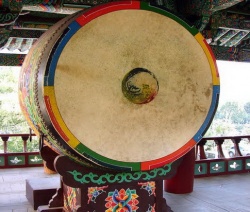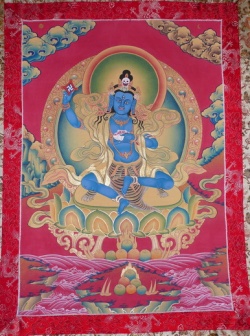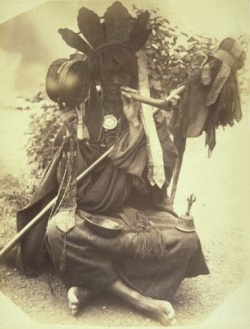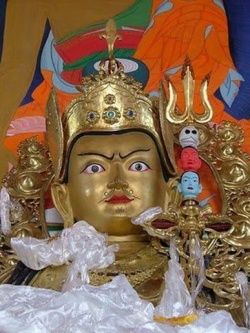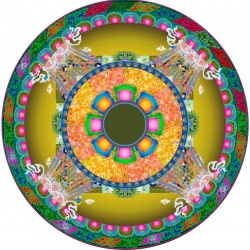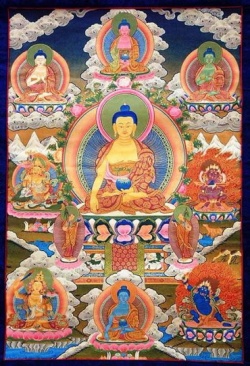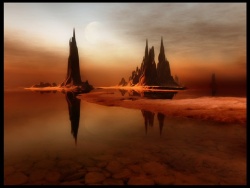The Bell and the Sound Symbols of Dharma
Just after the Buddha Śākyamuni attained Enlightenment on the Vajra Seat (Vajrāsana) beneath the Awakening Tree, He was hesitant to speak, certain that He would not be understood. He was even thinking to live out the rest of His days in a lonely forest retreat. The gods Brahma, famous for his melodious speech, and Indra, famous for his power, came to convince Him that it would
be worth the effort to begin teaching His insights in the form of the Dharma. The Wheel is one common symbol of the Dharma, since the Buddha is said to have ‘set the Wheel of the Dharma in motion.’ As a symbol of the same thing, Indra presented to the Enlightened One a Conch shell.
The sūtras, when they describe the Buddha’s first acts of teaching, prefer sound metaphors (or couldn’t we in fact call them auditory symbols?) that emphasize a pealing or booming quality, sounds that are clearly identifiable and sustained and
that carry for a long distance. Such metaphors as the Conch, the Large Drum, Melodious Brahma Voice, the Cymbal, the Lion’s Roar and the cry of the Kalapinka Bird are common in many sūtras.[1] Less common is the Thunder, and
later on we even find the cry of the Cuckoo Bird as a symbol of Buddha Word. These sounds are unified by their startling quality, communicating not only the Buddha’s act of vocalization as a kind of ‘wakeup call’ to greater awareness, but also the revolutionary nature of His revelation which, in His time, seemed to be coming right out of the blue... In a time when
Indian religious teachers were emphasizing the ultimacy of the Self or Atman, His revelation announced to the world that there is no such thing. In other words, these metaphors (they were never simply metaphors) served as symbols not only of the quality of the Buddha’s voice, but of the content of His message, with deep sounds to correspond to His depth of insight. But there is
still one further step to the symbolism that might be a little difficult to follow. It is nevertheless essential for a fuller understanding of these symbols. Since the Buddha’s expression of the Dharma tells us the way things are, the ‘things,’ i.e., the elements of apparent existence as Buddhistically conceived, are also called dharmas.[2] Hence, our sonorous symbols of Buddha Word are, besides being identified with the Buddhist scriptures which preserve His Word, equally identified with the world of phenomena.
The Bell as such (Ghaṇṭa in Sanskrit and Dril-bu in Tibetan[3]) is not listed among these metaphors of Dharma in the Mahāyāna Sūtras we have consulted.
Bells, in the plural, appear there rather as a meritorious offering which came to form a permanent fixture of the Buddhist reliquaries called Stūpas. These bells, probably rather small ones equipped with cloth hangings attached to their clappers that made them ring when the wind blew, were evidently hung in strings attached to Stūpas. Even without being explicitly identified with the Dharmas
(scriptural or phenomenal) in the Mahāyāna sūtras as far as we know at present,[4] the brief explanations of the symbolisms of the Bell in its entirety and in its parts all identify the Bell as the Transcendent Insight Sūtra, as well as the Voidness of all phenomena which is
the main message of that Sūtra. The head of Transcendent Insight even looks out at us from the center of the Bell’s handle.[5] Tsong-kha-pa, in his most famous work on the stages of the tantric Path, directly states, “The Bell’s sound symbolizes the proclamation of the masses of Dharma.”[6]
And Dragpa Gyeltsen says on the symbolism of the Bell in its entirety: “Its empty interior means Voidness, the main point of the Transcendent Insight (Sūtra). The center [of the Bell ] is the reality of Full Knowledge of awareness. Its sound indicates Voidness.”
Following closely Dragpa Gyeltsen’s brief explanations of the individual parts of the Bell, we start with the handle. The handle is composed of (in descending order) [1] a half-Vajra, [2] a Lotus (or Crown?), [3] a face, and [4] a vase of plenty. Although less common, some Bell handles incorporate a ring, below the face, which seems not to have any special
symbolism, but serves the utilitarian purpose of a thumb-ring to keep a better grasp.[7] This ring I think to be more common in Newar Buddhist examples. About the half-Vajra, Dragpa Gyeltsen says,
- “As for the Vajra, its use as a decorative covering is a symbol of Insight being ornamented by Method.”[8]
Like the prongs of the complete Vajra, the prongs of the half-Vajra are also supposed to be supported by a lunar disk resting on a Lotus, although the Lotus is not always clearly distinguishable in every example, frequently looking more like a crown for the face below.[9] The face is one element which is clearly present in nearly every example of the Tibetan Bell (if they have any designs on them at all) and, in nearly every explanation known to
us,[10] this face is identified as the face of Insight or Transcendent Insight, sometimes simply as the Mother (Yum),
while some authorities call it the face of Dharma[11] (I would say the latter is, given our earlier discussion, entirely apt, even if not directly supported in our particular Tibetan-language sources).
Here is Dragpa Gyeltsen’s explanation of the face:
- “Above [the vase] is a face of Transcendent Insight that indicates Dharma Body [and] Voidness.”
Dharma Body, usually understood to belong to the doctrinal category of Three Bodies of the Buddha, is also interpretable in some contexts as ‘the corpus of (Buddhist) teachings,’ while Voidness is the quintessential message of the Transcendent Insight Sūtra. The face looks
somewhat different in different examples. Usually it has a meditative expression, and very often a look of amusement, and what we are tempted to call a ‘knowing smile,’ such as the Buddha often has in the Transcendent Insight sūtras when He knows what His questioners really have
in mind when they ask their questions, or when He knows what the future will bring for them. She faces east, the direction of the rising sun (increasing light), and so in direct alighnment with the seed-syllable of Tārā, TAṂ, in the eight-petalled lotus below.
Beneath the face is a vase or pot, which Dragpa Gyeltsen calls “an elixir pot, as a symbol of the origination [or emergence) of all (magical and spiritual) attainments.” The attainments or siddhis may mean either ‘common’ magical powers or the ‘Supreme Siddhi’ which is just another way of saying Complete Enlightenment. Elixir often stands as a metaphor for the siddhis. The Indian
artistic motive of the Full Pot, the Pūrṇa Ghaṭa (or Pūrṇa Kumbha), is generally a symbol of wealth and abundance, but to follow Dragpa Gyeltsen, we would have to say that when it occurs on the handle of the Bell, it must refer to a wealth of spiritual
attainment much more than secular riches.[12] The vase is not always
clearly distinguishable on every Bell. Like the Makara faces on the Vajra’s prongs, the vase has often become artistically distorted or reinterpreted to the point that it is no longer clearly recognizable as such. At times it is simply absent, or replaced by the
ring. Since it has been persuasively argued[13] that the ‘inverted pot’ found near the tops of Indian pillars (including the famous Aśokan pillars) represents the pouring down of the heavenly waters, with all the crystal clear agrarian connotations of abundance and fertility that this entails, the upright overflowing pot has a similar symbolic meaning, if for the opposite reasons — it is not emptying out from above, but has been filled from above.
Proceeding down from the handle to the lower part of the Bell which is the Bell proper (Tāranātha calls it the belly of the Bell), we will divide it into two main parts, the dome and the slope: [1] the dome at the top of the Bell encircling the point where the handle
is attached (Tibetan texts on occasion refer to this part as the shoulder) and [2] the slope, or the external surface of the Bell which slopes down from the ‘dome’ to the ‘lip.’ The surface of the dome is always decorated with an eight-petalled lotus flower design.
[14] Within each of the eight petals is a ‘seed syllable,’ a Sanskrit letter represented in Tibetan transcription, each letter with a circle above it representing the Sanskrit anusvāra (in English transcriptions, represented as ‘ṃ’ usually pronounced like the ‘ng’ in ‘sung’).
The tops of the letters are pointing outward, away from the point where the handle is attached.[15] These eight syllables are the ‘seeds’ of eight female
Buddhas, which might be used as a basis for fully generating their forms in contemplative visualizations. These eight Buddhas are, to give their names according to their meanings in English (but the feminine grammatical endings are not translated here) with their
seed syllables: Buddha Eye—laṃ; Mother Mine—maṃ; White Robe—paṃ; Commitment Saviour—taṃ;[16]
Flowing Wealth—vaṃ, here represented in Tibetan as baṃ; Encourager—cuṃ, here represented in Tibetan as tsuṃ; Furrowed Brow—bhriṃ; Vajra Rosary—maṃ, repeated.[17] The presence of these female Buddhas on an instrument identified as being feminine in gender is significant.
Moving down to the slope of the Bell, we encounter first a circular band of horizontal Vajras. At the bottom of the slope, circling the outer part of the ‘lip,’ is still another circular band of Vajras that stand vertically. Both of these are protective circles; the upper band of Vajras
is called the Vajra Rosary, while the lower one is called the Vajra Wall in the Tibetan texts. Between these two bands is the greater portion of the surface area of the slope, and it is here that we find interesting differences in the designs which allow us to categorize various types of Bells.
To end for now with a few of the interesting details... The following typology of Bells is provided on the basis of an eighteenth-century Tibetan text,[18] since Dragpa Gyeltsen doesn’t mention the designs on this part of the Bell.[19]
There are six types of Bells. The first, called the Hero Bell, may have either five- or nine-pointed Vajra,[20] while the remaining five, named for the five Buddha Families, always have five points; hence we have the Tathāgata Family Bell, the Vajra Family Bell, the Jewel Family Bell, the Lotus Family Bell, and the Deed (or Sword)
Family Bell. It is not entirely clear which presently-available type of Bell the Hero Bell might be intended to designate.[21] The most commonly encountered type of Bell has eight different symbols depicted around the central part of the slope.[22] These eight symbols include the emblems of the five Buddha
Families, although the symbols are not always distinct enough to identify them with certainty, and there appears to be a certain amount of variation. The Tathāgata Family has as its heraldic emblem the Wheel of the Law, and so the Tathāgata Family Bell has a number of Wheels arrayed around the upper side of the slope. The Vajra Family Bell has Vajras, the Jewel Family Bell has Jewels, the Lotus Family Bell has Lotuses, and the Deed Family Bell has Swords.
Literary works
- V.W. AGRAWALA
- Joachim-Ernst BERENDT
- Nada Brahma, the World is Sound: Music and the Landscape of Consciousness, tr. by Helmut Bredigkeit, East-West Publications (London 1983). This book may make you think about sound like you never did before. Each chapter ends with footnotes to recorded music.
- Stephan BEYER
- Gouriswar BHATTACHARYA
- The Enigmatic Pot, contained in: Maurizio Taddei and Giuseppe De Marco, eds., South Asian Archaeology 1997, Serie Orientale Roma no. 90, Istituto Italiano per l’Africa e l’Oriente (Rome 2000), vol. 3, pp. 1342-1365. For a list of this author's publications in PDF, try this link.
- Lee BOWEN
- The Tropology of Medieval Dedication Rites, Speculum, vol. 16, no. 4 (October 1941), pp. 469-479. Available at JSTOR through subscribing institutions.
- DKON-MCHOG-BSTAN-’DZIN
- Bzo-gnas Skra Rtse’i Chu-thigs [‘The Arts: A Drop at the Tip of the Brush Hairs’] Krung-go’i Bod-kyi Shes-rig Dpe-skrun-khang (Beijing 1994). A modern textbook on Tibetan art history and techniques, ‘Drop of Liquid on the Tip of the [Brush-]hairs.’
- DPAL-SPRUL O-RGYAN-’JIGS-MED-CHOS-KYI-DBANG-PO
- The Words of My Perfect Teacher: Kunzang Lama’i Shelung, translated by the Padmakara Translation Group, Harper Collins (San Francisco 1994).
- DRAGPA GYELTSEN
- See Grags-pa-rgyal-mtshan.
- C.K. GAIROLA
- Évolution du pūrṇa ghaṭa (vase d’abondance) dans l’Inde et l’Inde extérieure, Arts Asiatiques, vol. 1 (1954), pp. 209-226.
- GRAGS-PA-RGYAL-MTSHAN
- Rdo-rje Dril-bu dang Bgrang-phreng-gi De-kho-na-nyid [‘The True Reality of Vajra, Bell and Rosary’], contained in: Sa-skya-pa’i Bka’-’bum, Toyo Bunko (Tokyo 1968), vol. 3, pp. 271-2-4 through 272-3-6.
- Peter HARVEY
- Venerated Objects and Symbols of Early Buddhism, contained in: Karel Werner, ed., Symbols in Art and Religion, Motilal Banarsidass (Delhi 1991), pp. 68-102.
- Mirielle HELFFER
- — Notes à propos d’une clochette gshang: Tibet et régions de culture tibétaine, Objets et mondes, vol. 21, no. 3 (Autumn 1981), pp. 129-134.
- — Du texte à la muséographie: données concernant la clochette tibétaine dril-bu, Revue de musicologie, vol. 68, no. 1/2 (1982) 248-269.
- — A Typology of the Tibetan Bell, contained in: B.N. Aziz & M.Kapstein, eds., Soundings in Tibetan Civilization, Manohar (N.Delhi 1985a), pp. 37-41. This is an abstract of the longer study in French in Arts Asiatiques (see below).
- — Essai pour une typologie de la cloche tibétaine dril-bu, Arts Asiatiques 40 (1985b) 53-67.
- KHAMS-STON
- Rgya Bod-kyi Nor-rdzas-kyi Ris Brtags-shing Dpyad-pa’i Dpyad Don Yid-kyi ’Dod-’jo, contained in: Bzo-rig Nyer-mkho Bdams Bsgrigs (Gangs-can Rig Mdzod series no. 14), Bod-ljongs Bod-yig Dpe-rnying Dpe-skrun-khang (Lhasa 1990), pp. 229-262. A treatise on how to recognize highly valued objects in Tibetan material culture, probably composed in the fifteenth century.
- KUN-GROL-GRAGS-PA (b. 1700)
- Gsang-sngags Theg-pa Chen-po’i Bsten-par Bya-ba’i Dam-rdzas Ji-ltar ’Chang-ba’i Rnam-bshad Rnal-’byor Rol-pa’i Dga’-ston (‘Feast of the Playacting Yogis: An Explanation on How to Hold the Commitment Substances for Use in the Great Vehicle of Secret Mantra’), contained in: Mkha’-’gro Bde-chen-dbang-mo, et al., Yum-chen Kye-ma-’od-mtsho’i Zab Gsang Gcod-kyi Gdams-pa Las Phran dang bcas-pa’i Gsung-pod, Tshering Wangyal, TBMC (Dolanji 1974), pp. 515-599.
- Eleanor OLSEN
- Catalogue of the Tibetan Collection and Other Lamaist Articles in the Newark Museum: Volume II, The Newark Museum (Newark 1950, reprint 1973).
- PRECIOUS DEPOSITS
- Precious Deposits: Historical Relics of Tibet, China, Morning Glory Publishers (Beijing 2000), in five volumes.
- Brian REPSHER
- The Rite of Church Dedication in the Early Medieval Era, The Edwin Mellen Press (Lewiston 1998).
- RONG-THA
- Rong-tha Blo-bzang-dam-chos-rgya-mtsho (1863-1917), Thig-gi Lag-len Du-ma Gsal-bar Bshad-pa Bzo-rig Mdzes-pa’i Kha-rgyan. An 85-folio treatise on Buddhist sacred arts, purchased in Lhasa in 1996. The printing blocks for this edition were originally kept at Rgyud-smad Grwa-tshang, the Lower Tantra College in Lhasa.
- Veronica RONGE and N.G. RONGE
- Casting Tibetan Bells, contained in: Michael Aris and Aung San Suu Kyi, eds., Tibetan Studies in Honour of Hugh Richardson, Aris and Phillips, Ltd. (Warminster 1980), pp. 269-276.
- Anna Maria ROSSI and Fabio ROSSI
- Beyond Lhasa: Sculpture and Painting from East and West Tibet (exhibition catalogue), Anna Maria & Fabio Rossi Publications (London 2002).
- A. ROSU
- Pūrṇaghata et le symbolisme du lotus dans l’Inde, Arts Asiatique, vol. 8, no. 3 (1961), pp. 163-194.
- Mkhas-dbang SANGS-RGYAS-RDO-RJE
- Responses to Various Polemical Writings, Sherab Gyaltsen Lama & Acharya Shedup Tenzin (Rewalsar 1985).
- R. Morton SMITH
- Pots without Pans, contained in: Devendra Handa and Ashvini Agrawal, Ratna-Chandrikā: Panorama of Oriental Studies (Shri R.C. Agrawala Festschrift], Harman Publishing House (New Delhi 1989), pp. 59-64.
- STAG-TSHANG LO-TSĀ-BA SHES-RAB-RIN-CHEN (1405‑1477 or 1478)
- Rten Gsum Bzhugs-gnas dang bcas-pa’i Bsgrub-tshul Rgyas-par Bshad-pa Dpal-’byor Rgya-mtsho. Microfilm of a 54-folio manuscript in the possession of Gyaltsen (Swayambhunath, Nepal) courtesy of the Nepalese National Archives (reel no. E574/29; running no. E15094). A treatise on Buddhist sacred arts composed in 1459.
- TSONG-KHA-PA
- Tsong-kha-pa Blo-bzang-grags-pa (1357-1419), Rgyal-ba Khyab-bdag Rdo-rje-’chang Chen-po’i Lam-gyis Rim-pa Gsang-ba Kun-gyi Gnad Rnam-par Phye-ba (=Sngags-rim Chen-mo; =Rje’i Gsung-’bum Ga-pa), Tibetan Cultural Printing Press (Dharamsala n.d.). A very famous treatise on Buddhist tantra in general by Tsong-kha-pa, credited with founding the Dge-lugs-pa School.
- Giuseppe TUCCI
- Sadhus et brigands du Kailash: Mon voyage au Tibet occidental, Editions R. Chabaud (Paris 1989).
- Gautama V. VAJRACHARYA
- Symbolism of Ashokan Pillars: A Reappraisal in the Light of Textual and Visual Evidence, Marg (Mumbai), vol. 51, no. 2 (Dec. 1999), pp. 53-78.
Footnotes
- ↑ 1.0 1.1 1.2 For examples of all of these, see the life of the Buddha as told in the Lalitavistara Sūtra, Chapter 26 entitled “Turning the Wheel of the Dharma.”
- ↑ 2.0 2.1 2.2 The lack of initial capital on the word dharma when used for the constituents (or qualities) of apparent existence is a Buddhological convention used when translating Buddhist texts into western languages. The original languages — Tibetan, Sanskrit, Pāli etc. — have nothing comparable to capital letters, and so the observance of this convention has nothing to do with Buddhist conventions. For believing Buddhists, the distinction between Buddha Word[s] and constituent[s] of apparent existence is an unnecessary one.
- ↑ 3.0 3.1 Although this might create some confusion, the Bell is often called in the texts Dorjé Drilbu (Rdo-rje-dril-bu), or Vajra Bell, since the Bell possesses a Vajra at its top. There are some places in the texts where the conjunctive syllable may be dropped (often for reasons of meter), and “Rdo-rje-dril-bu” may have to be read as meaning Vajra and Bell. Furthermore, Rdo-rje-dril-bu may appear in an abbreviated form as Rdor-dril. The ritual Bell of the Bon religion is quite different from that used in the other Tibetan schools. It is a very shallow, and might look more like a cymbal, except that it is equipped with a clapper. For a study of this Bon Bell called, in Tibetan, gshang, see Helffer (1981). It is evidently of Persian or Turkish origin. Mention of this instrument is not limited to Bon texts of the tantric types, but is also found, together with the drum, as a metaphor for the proclamation of the Golden Light Radiant Jewel (Gser-’od Nor-bu ’Od-’bar) Sūtra, and it is explicitly called one of the ‘symbols of the Word’ (bka’ rtags, the other symbols being the drum, conch and something called slang, possibly a metal bowl used as a ‘gong’ or some other cymbal-like instrument) in the apparently eleventh-century biography of Lord Shenrab, the Condensed Scripture (Mdo-’dus), to give two examples. It occurs in Bon religious art as an attribute of deities both peaceful and wrathful. That Bonpo teachers might nevertheless make use in rituals of the usual Buddhist Vajra and Bell is proven by photographs in Tucci (1989: 182, and text on p. 184), although this would seem to be a characteristic of New Bon (Bon Gsar). One further interesting use of the Bell ought to be mentioned. Certain groups of non-Buddhist peoples in northern Assam, people who gained their livelihoods through hunting and gathering, employed the Bell in a secular way, as a form of ‘currency’ which they used in bartering. The Tibetans who originally supplied them with the Bells would remove the handles before using them to purchase goods from the Assamese. Evidently, Bells devoid of their half-Vajra-tipped handles were no longer viewed as sacred objects.
- ↑ 4.0 4.1 We can be fairly certain of what we are saying here on the absence of Bells-as-symbols-of-Dharma, since we were able to consult the texts of the Transcendent Insight and a number of other important Mahāyāna sūtras in electronic versions prepared by the Asian Classics Input Project. This makes it possible to locate quickly every occurrence of a word in the text of the sūtra (of course one still must take care to consider the possibility of wrong or unusual spellings and typographical errors as well as synonyms, epithets, etc., which computers have not been trained to ‘catch’). These days, we also have the Vienna site, subject of this Tibeto-logic blog page. I haven’t had time to look into the several hundred occurrences of the word Dril-bu in the Kanjur texts, but my impression is that in nearly all cases they are the strings or networks (dra-ba) of bells used to decorate stūpas. The word dril-bu is frequently used together with g.yer-ka in the sūtra contexts. A quite typical phrase is gser-gyi dril-bu g.yer-ka'i dra-ba. There is often a mention of how they make their sounds when the wind blows, which does tend to make us think of wind chimes more than bells. In any case the material on bells in the Tibetan canon overall is so great that I hope some ambitious person will take up the challenge of studying it all. I haven’t.
- ↑ For the symbolism of the Bell and its parts, we are fortunate to have a set of excellent contributions by Mireille Helffer (1982, 1985a, 1985b), and our discussion is in some degree based on them, but with our emphasis given to the Tibetan-language work by Dragpa Gyeltsen.
- ↑ Tsong-kha-pa (n.d.: 564).
- ↑ According to Rong-tha (n.d. 79), the ring is placed here on no other authority than the craft tradition itself (meaning it isn’t justifiable from scriptural and commentarial works). Kun-grol-grags-pa (1974: 533) says that the hole (bug-pa) is not taught in any transmission lineage (brgyud, but I think he intends rgyud, ‘tantra’). One example of a remarkable Ming Dynasty Bell (a Chinese inscription in its interior identifies it as belonging to the reign of Yongle) which includes a ring in its handle has been published (Precious Deposits 2000: III 224-5), but it seems that the handle could have been added to the Bell at a later date. Many Bells with rings seem to be of Nepalese origin. Even much more rarely, Phurpas may have rings attached (a purportedly 12th-century example from the Dali Kingdom of presentday Yunnan Province was offered for sale in Rossi & Rossi 2002), and probably with a similar motive, to keep the implement from flying out of the hands during ritual usage.
- ↑ Feminist thinkers may find it cause for delight or dismay that here Dragpa Gyeltsen makes Father Method subservient (‘ornamental’) to the face of Mother Insight. She wears the Vajra of Voidness as Her crown, since Voidness is Her ultimate insight.
- ↑ The face is often described in the non-Tibetan-language literature as being ‘crowned,’ but among our Tibetan texts only Rong-tha (n.d. 78) states this explicitly. Ignoring the texts, and basing ourselves entirely on visual aspects, it often does look as if there is a crown, but a crown ought to have five ‘lobes’ for the five Buddha Families. On the example in hand, there are eight ‘lobes’ entirely encircling the handle. Therefore we prefer to interpret these ‘lobes’ as being rather lotus petals intended to ‘support’ the Vajra prongs (as in the symbolism of the Vajra discussed above) rather than to ‘crown’ the face.
- ↑ Except for a late Dge-lugs-pa text, which says that when the Bells are distinguished by Buddha Families (see below), the face should be the face of the main Buddha of the family to which the Bell belongs (Helffer 1985b: 58). Tāranātha (1983a) suggests that a wrathful Bell ought to have a face with wrathful appearance. Stag-tshang (n.d. 32) refers to the Face as that of the ‘Blessed Lady’ (Bcom-ldan-’das-ma) or, in another place, that of ‘Transcendent Insight’ (Sher-phyin). Dpal-sprul (1994: 187), writing in the nineteenth century, says “The bell bears the image of a face which, according to the outer tantras, is that of Vairochana and, in the view of higher tantras, is Vajradhatvishvari.” (Most surprising here is the possibility of identifying the face as Vairocana’s, Vairocana being a Buddha with male form.)
- ↑ Olsen (1950: 35), for example, says, “the head of the goddess Dharma or Prajna, ‘Supreme Wisdom’.” One scriptural source, the Sampuṭa Tantra (Derge Kanjur, vol. 79 [ga], fol. 289 recto), is quite explicit about the face at the center being that of ‘Goddess Prajñāpāramitā’ (Lha-mo Shes-rab Pha-rol-phyin), further specifying that it should, in its shape, be beautiful and endowed with qualities. This text also describes a lotus as being above the face, with no mention of a crown. This scriptural evidence strengthens the impression that the globular part at the center of of the Vajra is meant to correspond to the face at the center of the Bell.
- ↑ On the Indian symbolism of the Full Pot, see Gairola (1954), Rosu (1961), Agrawala (1965: 10-11, 43-46), Coomaraswamy (1971, pt. 2: 61-64), and especially Bhattacharya (2000). Smith (1989) gives evidence for its antiquity in Buddhist architecture in which it is associated with pillars. See as well Harvey (1991: 74-76), where an argument is made for a Buddhist interpretation which would emphasize the ‘fullness’ of the Buddha’s Teachings, the Dharma, which fits nicely with the other symbolic motives found on the Bell. The lotuses or Bodhi tree sometimes depicted growing from the pot would then be a symbol of spiritual growth nourished by the resources of the Buddha’s Teachings. The reference to an ‘elixir pot’ reminds us of the Indian cosmogonical story of the churning of the Milk Ocean that resulted in, among other things, the production of the divine sustenance or ‘elixir,’ a drink of immortality, which was placed in a pot. Pots filled with water, with leaves and other decorations decorating their mouths, have been, and still are, used during deconsecration/reconsecration rituals, as temporary abodes for the deities when images or stūpas are being repaired. I would further suggest that all the elements of the Bell handle above the Full Pot ought to be conceived as emerging out of it.
- ↑ Vajracharya (1999: 53-64).
- ↑ See Ronge (1980), where the process of bell-making is described in some detail. The decorations on the ‘dome’ are directly transferred to the mold from the ‘blank’ prototype Bell that is used to form the mold, but the decorations on the ‘slope’ have to be subsequently stamped onto the inside of the mold. This explains why the decorations on the ‘slope’ are often less distinct than the decorations on the ‘dome.’ We ought to emphasize that the names ‘slope’ and ‘dome’ do not come from our Tibetan-language sources, while the term ‘lip’ is in fact used by them.
- ↑ The ‘garland of letters’ is very deeply rooted in Indian religious history, and we will not attempt to trace its history here. One finds it in the Cakrasamvara tantric system’s visualization of the ‘seat’ of the deity. Here the vowels (for ‘insight’) circle counterclockwise twice and transform into the lunar disk, while the consonants (for ‘method’) circle clockwise twice and transform into the solar disk. The seat being the ‘site’ of the enlightened being that is seated on it, the letters, in this case the Sanskrit letters transcribed into Tibetan, are both the seeds of the sacred scriptures and the initial definition of the sacred space. (See, for example, Beyer 1973: 112.) Quite similar, even with its differences, is the rite that forms a part of Catholic church consecration rituals called the abecedarium, in which two lines of the Latin and Greek alphabets (the alphabets of the two sacred languages used in traditional [pre-Vatican II] Catholic scriptures and sacred chants) are inscribed from corner to opposite corner forming an ‘X’-shaped cross. These alphabets are “the beginnings and basics of sacred doctrine... and the beginnings of the Word of God” (Repsher 1998: 82; see also Bowen 1941: 475). Given the obviously different arrangements of the letters in circles and crosses, nevertheless the similar in their usages of ‘seed’ letters of scripture to define sacred spaces is impressive.
- ↑ The syllable taṃ is symbolically oriented toward the east, and the Face in the middle of the handle is also supposed to be oriented in the same direction. Stag-tshang (n.d. 33) calls this an ‘Inner Bell.’ He also describes as an ‘Outer Bell’ one that has a ring below the Face as well as the seed syllable or emblem of Buddha Eye in the east. The arrangement of seed syllables in Kun-grol-grags-pa (1974: 531-532) is quite different.
- ↑ The lists of eight female Buddhas are not always the same. Especially the last four frequently vary from our list, which is derived from Dragpa Gyeltsen’s work. We have not attempted to sort out the reasons for this variation. The ‘seed syllables’ of these Buddhas are formed simply by taking the first letters of their names (in their original Sanskrit form) and adding anusvāra.
- ↑ This work by Kun-grol-grags-pa, an eighteenth-century Bon-po teacher in Eastern Tibet, is discussed in Helffer (1985), and we have based our explanation on this.
- ↑ Although this cannot be accomplished here, it will be interesting in the future to consider how the designs on this part of the Bell might have developed over time. It is a possibility that Dragpa Gyeltsen doesn’t mention these design elements because they were not commonly in use in his time. One Tibetan text suggests that earlier Bells might have been less decorated. See Khams-ston (1990: 256), where it says that there exist unornamented bronze Bells in Tibet which were made by Indian craftspersons. These are said to be Bells especially meant to be used in dance performances, and are sometimes called ‘old Tibetan’ (Bod rnying) Bells. I have seen a set of relatively unornamented Vajra and Bell offered for sale in Kathmandu at a tremendous cost (300,000 Nepalese rupees, to be exact; perhaps 3,000 US dollars), a price justified by the dealer since, according to her belief, the set had been imported to Tibet from India in the eleventh century. The Bell was unornamented except for the half-Vajra at the top and a few highly-worn decorative bands around the ‘slope.’ Buyers beware, however, especially since nowadays many if not most Bells are manufactured to have a worn appearance, and so the indistinctness of the decorative elements (which may also result from the method of casting, as mentioned in an earlier note) is not in itself necessarily a proof of antiquity.
- ↑ According to Kun-grol-grags-pa (1974: 530), “Nowadays [most common are the] five-pointed Vajra used in peaceful and extending (ritual actions) and the nine- pointed Vajra used in influencing and overpowering (ritual actions).” Evidently Bells topped by Vajras of like number of points would share the same ritual usage.
- ↑ The problem is discussed in some detail in the works of Helffer listed below. According to Rong-tha, as well as Dkon-mchog-bstan-’dzin, it has the two Vajra bands as the only decoration on its slope. It lacks the emblems as well as the pearl strings (to be described presently). Sangs-rgyas-rdo-rje (1995: 13) distinguishes three types of Bells. The first is the Vajradhāra Bell (nine-pointed only), the second the Hero Bell (five- or nine-pointed), and the third the Particular Family Bell (five-pointed only). The last one includes the five different Bells belonging to the five Buddha Families. He defines the Hero Bell (on p. 17) as a five- or nine-pointed Bell which has the Vajra Rosary, but in which the latticework of pearl strings is replaced by insets of precious substances (gold, silver or gems).
- ↑ According to Dkon-mchog-bstan-’dzin (1994: 314), this type of Bell with eight different emblems is called the Vajra Being Full Knowledge Bell (Rdor-sems Ye-shes-kyi Dril-bu).

